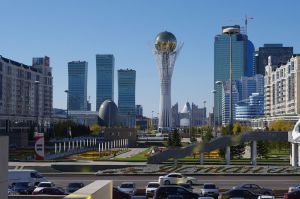
Civil projects constitute some of the most visible and symbolic actions of the state. Buildings, monuments, bridges, urban reorganisation, and dams, amongst nearly countless other programmes, can serve a wide array of functions: propaganda, potent displays of public resource allocation, political manipulation, civic pride, improvement of health, welfare, and education. Their development (usually) necessitates job growth, and their completion can do much to promote regional and national interests in the international community. Civil projects are also a near-universal behaviour. From Los Angeles’ expansion of its fledgling public transport system and the 2012 London Olympic Games, to Pyonyang’s infamous (and unfinished) Ryugyong Hotel, public projects can heavily influence local and global conceptions of national power, stability, priorities, and culture.
Who decides how a city – especially a national capital – is going to look? What image(s) of itself does the city want to project or obscure? Who gets a say, and who doesn’t? Natalie Koch (Syracuse University) tackled these questions in the most recent Transactions of the Institute of British Geographers. In ‘Bordering on the modern: power, practice and exclusion in Astana’, Koch examined the remarkable creation and expansion of Kazakhstan’s post-Soviet capital, which creatively, is Kazakh for capital. Long-serving president Nursultan Nazarbayev’s flagship programme, Astana has come to at once symbolise Kazakhstan’s meteoric rise as a regional power and the country’s increased notoriety as a centre of cultural creativity and experimentation, as well as an enduring example of the problems of (even relatively benevolent) authoritarian rule.
Scholars have been fascinated by the ‘Astana phenomenon’ since construction began on top of the small Soviet-era city of Tselinograd in the mid-1990s. Most recently, Charles E Ziegler, Isabelle Facon, and Jean-Pierre Cabestan, writing in Asian Survey, identified Astana’s successful 2010 Shanghai Cooperation Organisation (SCO) summit as symbolically demonstrative of the city’s rising importance in Asian international affairs. But these specialists, by and large, have conceived of Astana in strictly ‘top-down’ terms, without examining how intricate sociopolitical negotiations between various factions continuously develop the city.
Koch’s approach is substantively different. In both ‘Bordering on the modern’ and a series of previous studies on Kazakhstan’s urban development, she has sought to recover the voices and desires of average Kazakhs, not just those who control the capital’s space age-looking skyscrapers and monuments (p. 433). To accomplish this goal, she identified and collected data from both elites and other urban actors to paint the most comprehensive image of Astana’s development culture we yet have.
Cities, by their very nature, are constructed of borders and bordering. These borders are not the traditional rigid, red-coloured lines we usually see in atlases, but rather active, discursive, processes of inclusion and exclusion, acceptance and ‘othering’. When particular (group)s press for change, redevelopment, expansion, or shifts, they are attempting to redefine who and what gets accepted or othered. When Nazarbayev’s engineers set out to erect a new capital for a newly-independent state, they didn’t entirely know what they wanted to achieve. They did know, however, what they wanted to ‘other’: Astana would not be a Soviet city. Ironically, the elites who designed and funded the first, new wave of capital construction drew on Soviet-influenced models to establish a distinctly non-Soviet city:
[T]he Astana project draws on similar visions and has been an important site for enacting Nazarbayev’s vision of Kazakhstan’s post-Soviet modernity. And yet, these elites are heavily influences by a distinctly Soviet-era understanding of the ‘city’ – in terms of both its function and its symbolism (p. 434).
With that in mind, however, Kazakh elites also used this opportunity to raze thousands of poor Kazakhs’ samannyi, or mud-brick buildings that had been built on Tselinograd’s periphery. Both Soviet practices of architectural standardisation and low-income housing were deemed incompatable with Nazarbayev’s vision of a culturally representative, deliberately eclectic urban aesthetic. This development would suggest that elites have simply imposed a top-down reinvention of Kazakhstan’s capital, but the truth is more complex and interesting than that. Even as Kazakhstan deals with the many problems of capitalism without significant democratic liberalisation – a conundrum that promotes a rich, powerful oligarchy at the expense of relatively poor masses – many city spaces are being designed with the collective public in mind. Malls, in particular, serve as a popular social rendezvous, even for those without sufficient means to purchase many of the higher-end products sold in their stores. Architects are gradually accepting this social phenomenon, creating indoor/outdoor fixtures that promote social interaction.
Nevertheless, much of Astana’s middle- and poorer-classes increasingly resent the iinordinatecontrol of Astana’s elite over the city’s future political and cultural directions. Fault lines divide Astana between ‘northerners’ (traditional, ‘Russified’ urbanites), and ‘southerners’ (rural and recently urbanised Kazakhs), who wrangle for political and financial power, redistributing funds to their own, respective urban projects and political balances shift (p. 438).
See special issue of Asian Survey 53.3 (May-Jun., 2013).
![]() Koch N, ‘Bordering on the modern: power, practice and exclusion in Astana‘, Transactions of the Institute of British Geographers New Series 39 432-43.
Koch N, ‘Bordering on the modern: power, practice and exclusion in Astana‘, Transactions of the Institute of British Geographers New Series 39 432-43.
